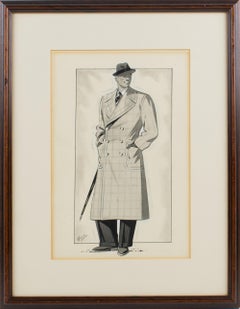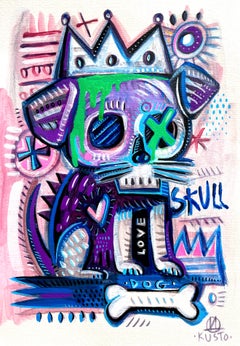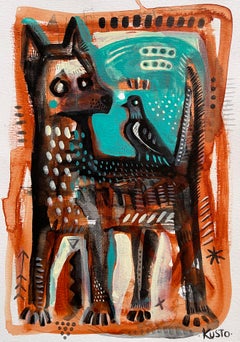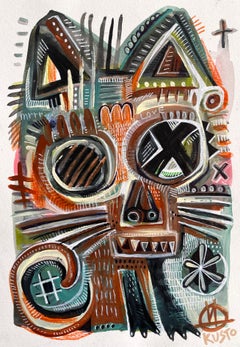Vertical Portrait Drawings and Watercolors
1930s Art Deco Portrait Drawings and Watercolors
Paper, Ink, Watercolor
2010s Pop Art Portrait Paintings
Permanent Marker
2010s Pop Art Portrait Paintings
Permanent Marker
2010s Pop Art Animal Paintings
Acrylic, Permanent Marker
2010s Neo-Expressionist Animal Paintings
Permanent Marker, Acrylic
2010s Neo-Expressionist Portrait Paintings
Permanent Marker
18th Century Rajput Figurative Drawings and Watercolors
Gold
17th Century Rajput Figurative Drawings and Watercolors
Gold
17th Century Rajput Figurative Drawings and Watercolors
Gold
18th Century Rajput Figurative Drawings and Watercolors
Gold
2010s Pop Art Animal Paintings
Acrylic, Permanent Marker
18th Century Rajput Figurative Drawings and Watercolors
Gold
Mid-20th Century Academic Portrait Drawings and Watercolors
Paper, Graphite
16th Century Old Masters Nude Drawings and Watercolors
Ink
1930s American Modern Portrait Drawings and Watercolors
Paper, Charcoal
2010s Contemporary Portrait Drawings and Watercolors
Tempera, Ink, Pencil
Early 19th Century Portrait Drawings and Watercolors
Watercolor
Mid-19th Century Portrait Drawings and Watercolors
Watercolor
Early 19th Century Portrait Drawings and Watercolors
Watercolor
19th Century Rajput Figurative Drawings and Watercolors
Gold
1980s Impressionist Portrait Drawings and Watercolors
Watercolor, Gouache
Mid-20th Century Impressionist Portrait Paintings
Watercolor, Gouache, Pencil
2010s Pop Art Animal Paintings
Acrylic, Permanent Marker
2010s Contemporary Figurative Drawings and Watercolors
Charcoal, Laid Paper
1910s Post-Impressionist Portrait Drawings and Watercolors
Conté, Carbon Pencil
Early 19th Century English School Portrait Drawings and Watercolors
Watercolor, Glass
Early 19th Century English School Portrait Drawings and Watercolors
Paper, Watercolor
19th Century Portrait Drawings and Watercolors
Watercolor
1980s Neo-Expressionist Figurative Drawings and Watercolors
Paper, Oil Pastel, Mixed Media
Late 19th Century Modern Figurative Drawings and Watercolors
Paper, Pencil
20th Century Modern Portrait Drawings and Watercolors
Carbon Pencil
18th Century Rajput Figurative Drawings and Watercolors
Gold
2010s Contemporary Figurative Drawings and Watercolors
Paper, Ink, Watercolor
Mid-20th Century Surrealist Portrait Drawings and Watercolors
Paper, Charcoal
2010s Neo-Expressionist Portrait Paintings
Acrylic, Permanent Marker
Mid-20th Century American Modern Figurative Drawings and Watercolors
Paper, Charcoal
1980s Modern Portrait Drawings and Watercolors
Paper, Ink
Mid-20th Century American Modern Portrait Paintings
Paper, Oil Pastel, Gouache
2010s Neo-Expressionist Portrait Paintings
Acrylic, Permanent Marker
18th Century Rajput Figurative Drawings and Watercolors
Gold
1970s Expressionist Animal Drawings and Watercolors
Paper, Gouache
1950s Art Deco Figurative Drawings and Watercolors
Gouache
1910s Portrait Drawings and Watercolors
Paper, Watercolor
1860s Romantic Portrait Drawings and Watercolors
Chalk, Charcoal
Early 19th Century French School Portrait Drawings and Watercolors
Handmade Paper, Chalk, Graphite
19th Century Naturalistic Portrait Drawings and Watercolors
Charcoal, Pencil
19th Century English School Figurative Drawings and Watercolors
Paper, Chalk, Charcoal
Late 18th Century Rococo Portrait Drawings and Watercolors
Pastel, Paper
19th Century Rajput Figurative Drawings and Watercolors
Gold
2010s Pop Art Portrait Paintings
Permanent Marker
Mid-19th Century American Modern Figurative Drawings and Watercolors
Paper, Charcoal
1930s American Modern Portrait Drawings and Watercolors
Paper, Charcoal
Mid-19th Century Academic Portrait Drawings and Watercolors
Paper, Charcoal, Carbon Pencil
Early 20th Century Modern Figurative Drawings and Watercolors
Paper, Pencil
19th Century Portrait Drawings and Watercolors
Watercolor
Early 20th Century Portrait Drawings and Watercolors
Watercolor
2010s Pop Art Portrait Paintings
Permanent Marker
2010s Contemporary Portrait Drawings and Watercolors
Ink, Tempera, Pencil
2010s Contemporary Portrait Drawings and Watercolors
Crayon, Pencil, Paper
1910s American Impressionist Drawings and Watercolor Paintings
Graphite



